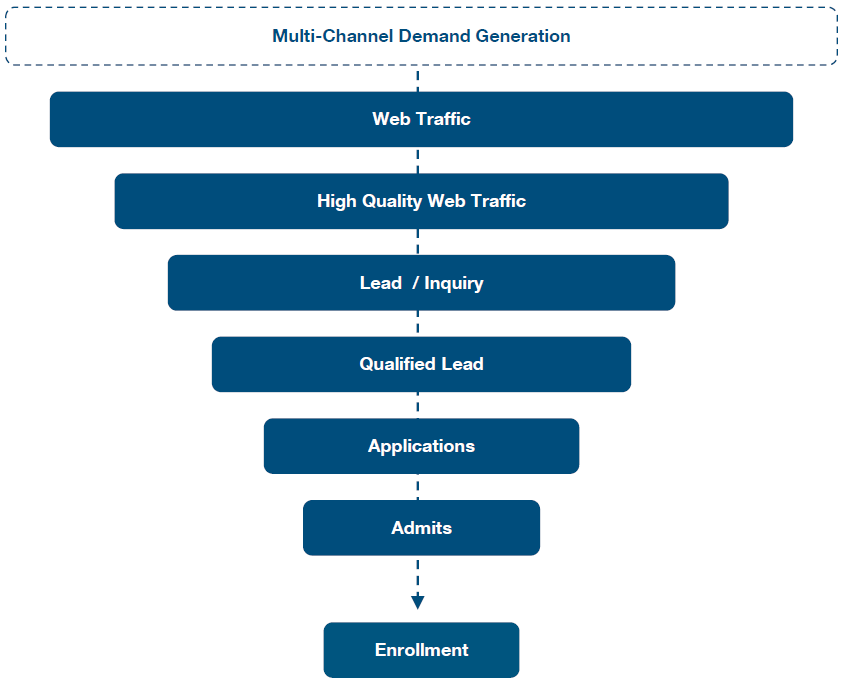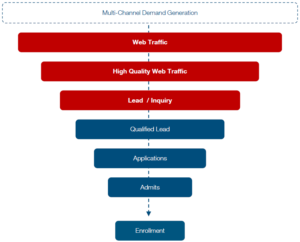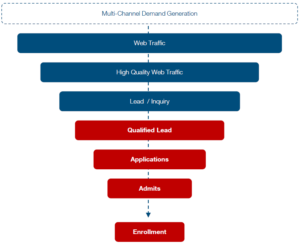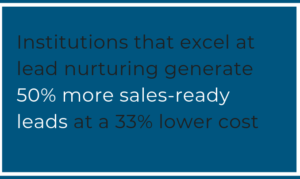Why You Need Full Funnel Lead Nurturing for Adult Learners
Full Funnel Lead Nurturing: Where a majority of universities struggle
In today’s professional education landscape, competition for student enrollments is stronger than ever and institutions are bringing in help to achieve their enrollment goals. In the latest UPCEA Marketing Survey, most respondents (79%) in the professional, continuing and online education market outsource at least some of their marketing needs, and 3% outsource everything.
If your organization is investing marketing budget towards filling the top of its enrollment funnel with qualified prospective students, it’s important to maximize that investment by providing prospects with an exceptional user experience once they enter your pipeline, or you could lose out to your competition.
While attracting prospective students is a challenge in and of itself, building an effective lead nurturing strategy is paramount towards achieving the greatest return on your marketing investment. To be successful, you need to be a full-funnel marketer—that means considering the student’s entire decision-making process when implementing your marketing strategy.
Top reasons why your institution should be nurturing its leads
- You will convert inbound traffic to enrollments at far greater percentages
- You will strengthen the relationship between your prospective students
- It will allow you to deploy your media spend more efficiently
- You will gain valuable insights into the decision-making process and timelines of your prospect pool
How long does lead nurturing take?
The student decision-making process varies greatly based on the program type, modality, and strength of the institution’s brand, so take these factors into account when building your lead nurturing strategy. Programs that require a larger financial and time investment are likely to take a great deal more nurturing before the student is ready to take the next step. Your content strategy should be tailored to your individual programs. Here are some examples of how long lead nurturing may take.
Typical decision-making timelines across program types:
(From lead to application)
1-2 months
- Non-credit certificates/courses
6-9 months
- Online graduate certificates
- (15-20 credits)
9-12 months
- Online master’s degree programs
- (40-60 credits)
12-15 months
- On-campus (in-person) master’s degree programs

Enrollment funnel stages
Because prospective students’ needs are different at each stage in the funnel and for each program type, nurturing prospective students along their entire journey to give them what they need is ideal. The goal is to increase conversion rates at each stage of the process by providing timely, relevant communications that increase engagement.
Models for enrollment funnels vary a great deal from organization to organization and are greatly dependent upon which steps your prospective students are required to take throughout their enrollment journey. Regardless of the number of stages, the process of funneling the decision-making behavior of your prospects from awareness to consideration to enrollment remains the same.
Here is the MindMax enrollment funnel:

Top of the Funnel (TOFU) – Awareness Stage
This includes multi-channel demand generation.

Prospective students have identified a problem and are looking for answers, but they aren’t ready to become a student just yet. Content should be educational making people aware of your solution. Create content that will drive more qualified prospects to your website so you can collect more information to start having conversations.
The tactics to focus on are digital marketing services that support demand generation and lead capture.
Common tactics:
- Paid search
- Organic search (SEO)
- Contextual display ads (prospecting)
- Digital remarketing ads
- Social media advertising (direct sponsored content)
- Content marketing (gated content strategies)
The goals are to create awareness and drive website traffic.
Middle of the Funnel Stage (MOFU) – Consideration Stage
This stage includes website traffic to leads.

Prospects at this stage have moved from thinking they want to “return to school,” to “I am considering enrolling in a particular program.” Content here should be comparative; differentiating. Why is your institution and/or program the best choice?
Focus on digital marketing services that support lead nurture and convert students to become applicants.
Common tactics:
- Automated email campaigns
- Lead scoring modeling
- Digital remarketing strategies
- Live Chat
The goals are to gain actionable lead population intelligence data that will inform conversion, predictability, and forecasting.
Bottom of the Funnel (BOFU) – Decision Stage
This stage includes qualified leads to enrollments.

Prospective students at this stage have signaled their intent by submitting their application, but your work isn’t done yet. Most prospects at this stage are still considering multiple programs and institutions. Content that promotes your most important value propositions is key here. Share student and alumni testimonials, faculty stories, and professional outcomes (job placement opportunities).
At this stage, focus on multi-channel tactics that will support application through to enrollment.
Common tactics:
- Automated email campaigns
- Live chat
- Outbound call campaigns
- Digital remarketing strategies
The goals are to create prospect engagement, and an optimized enrollment strategy including an optimized CRM that can help manage your enrollment funnel.
Takeaways
By expanding your lead nurturing efforts to the full funnel, you’ll increase enrollment potential and elevate the prospective student’s experience. The goal is to increase conversion rates at each stage of the process by providing timely, relevant communications to increase engagement with prospective students.
Do you have any lead nurturing best practices to share? We’d love to hear them. Comment below.
Related Ideas
Is Your Enrollment Management Function Set Up for Success?


